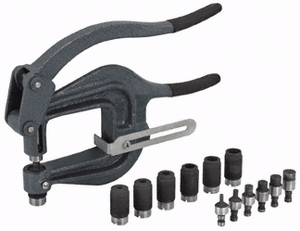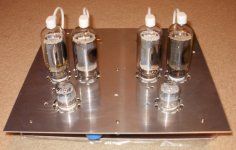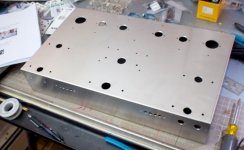Titanium or carbide drill bits up to 1/2" or so. Greenlee chassis punches or equivalent for holes up to 1 1/2" and a nibbling tool for odd sized or shaped holes.
Most of my chassis are aluminum from bud, hammond, or SMB. Easily worked which is why I mention them. Sometimes (rarely now) I make them from scratch if I have access to a good bending brake.
Steel is really hard on drill bits and punches.
While drilling use lubricants, remove swarf frequently. Lubricate draw bolt on punches, or better still get one with bearing if possible.
Be safe! (Wear safety glasses!)
Kevin
Most of my chassis are aluminum from bud, hammond, or SMB. Easily worked which is why I mention them. Sometimes (rarely now) I make them from scratch if I have access to a good bending brake.
Steel is really hard on drill bits and punches.
While drilling use lubricants, remove swarf frequently. Lubricate draw bolt on punches, or better still get one with bearing if possible.
Be safe! (Wear safety glasses!)
Kevin
I use a conical step drill to make holes, then open them out if needed with a nibbler. The holes a lot of the time need a bit of deburring - I just use a drill somewhat bigger than the hole to clean the crud away.
plain hard work
first mark out 3mm or so from the perimeter, use a dot punch to mark reasonable distances for a 4mm drill bit. the idea is to end up with holes very near to each other. using a bench press, drill the required holes. use a hacksaw blade to saw thru all the holes, causing the inside piece of metal to fall out. then finish off with a metal file.
i did the below on a 5mm piece of aluminium. the cutout was for a led display for my preamp.
for thinner metals, you might want to check this tutorial.
cheers
garbage
elementx said:how do you? jigsaw? tiedious drilling?
i'm refering to socket holes, transformer holes...
first mark out 3mm or so from the perimeter, use a dot punch to mark reasonable distances for a 4mm drill bit. the idea is to end up with holes very near to each other. using a bench press, drill the required holes. use a hacksaw blade to saw thru all the holes, causing the inside piece of metal to fall out. then finish off with a metal file.
i did the below on a 5mm piece of aluminium. the cutout was for a led display for my preamp.
for thinner metals, you might want to check this tutorial.
An externally hosted image should be here but it was not working when we last tested it.
An externally hosted image should be here but it was not working when we last tested it.
An externally hosted image should be here but it was not working when we last tested it.
cheers
garbage
80 bucks on ebay in Australia gets you a 10 ton press that knocks holes in 3mm mild steel and no burrs!!
There are lots of Chinese made Hydraulic chassis punches on Ebay. about $A150.00
i have found they are very good, not as good as the Japanese hydraulic chassis punches, but they cost $1500.
Phil
i have found they are very good, not as good as the Japanese hydraulic chassis punches, but they cost $1500.
Phil
Greelee hole punches for tubes and stepped drill bits for up to 3/4 inch. The Greelee punch is just a little too small and holes get a final sanding for the sockets to just pop through. I leave a little clearance for thermal expansion when the tubes heat up.
For the tube vent slots I use a jig to hold the axle for the center of the tube in a mill and use a 3/16" 4 flute bit and rotate the top to get the arc needed. Lift the bit, rotate to the new spot, drop the bit and rotate the top plate again.
For the tube vent slots I use a jig to hold the axle for the center of the tube in a mill and use a 3/16" 4 flute bit and rotate the top to get the arc needed. Lift the bit, rotate to the new spot, drop the bit and rotate the top plate again.
Attachments
I've used punches, verticle mill, and water jet cutting. Lately, I've been toying around with the idea of using carefully formed charges of C-10.
Mark
Mark
I drill a pilot hole then use a boring head on a milling machine. Don't have any punches, so have to go with what you have.
I found a source that has a waterjet that can cut 1/2 steel, they can use a DXF file from Autocad, so if it were to be cost effective, that would be another way.
Another source quoted around $120 for 2, laser cutting. I don't know how much slag would build in the curf.
I'm kinda twisted, those are triple triode compactrons driving 6LB6 outputs.. 12 pinners.
Another source quoted around $120 for 2, laser cutting. I don't know how much slag would build in the curf.
I'm kinda twisted, those are triple triode compactrons driving 6LB6 outputs.. 12 pinners.
I found a source that has a waterjet that can cut 1/2 steel, they can use a DXF file from Autocad, so if it were to be cost effective, that would be another way.
Another source quoted around $120 for 2, laser cutting. I don't know how much slag would build in the curf.
I'm kinda twisted, those are triple triode compactrons driving 6LB6 outputs.. 12 pinners.
Laser cutting is clean, we have aircraft parts laser cut, saves time and has a real clean cut.
Mac
The Book Worm - DIY Audio Ebooks and Manuals - Speakers, Moscode Amplifiers, Electronics, Map Reading, Free Capacitor Intro.
Roline....before you fork out that much money check and see if there is someplace that does EDM in your area. Works great on thicker material and should be substantially cheaper. Off topic, but i had 2 magazine wells cut on rifle receivers i was making. Accurate cuts and smooth as the proverbial baby's bottom. regards, J.D.
There was a discussion on this before. http://www.diyaudio.com/forums/tubes-valves/174096-need-decent-chassis-punch-set.html
For holes larger than 1/4 inch, I use Greenlee punch set I found used on ebay. For small holes, I use deep throat metal hand punch.

The real one is $250 but I bought an imitation from ebay for $55. It's good enough for one or two projects but beyond that, it will wear out (because it's a cheap imitation). But it's still better than having to "set" the hole with set punch and possibly bend the plate and then trying to hold a drill bit in place for small holes. The hand punch produces more accurate location.
For holes larger than 1/4 inch, I use Greenlee punch set I found used on ebay. For small holes, I use deep throat metal hand punch.

The real one is $250 but I bought an imitation from ebay for $55. It's good enough for one or two projects but beyond that, it will wear out (because it's a cheap imitation). But it's still better than having to "set" the hole with set punch and possibly bend the plate and then trying to hold a drill bit in place for small holes. The hand punch produces more accurate location.
- Status
- Not open for further replies.
- Home
- Design & Build
- Construction Tips
- How do you punch out your chassis holes?

